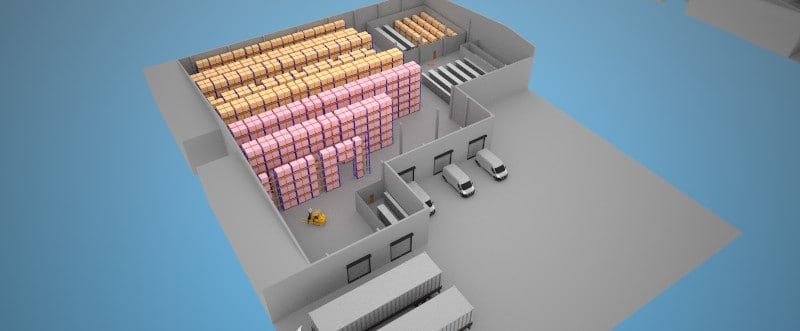Introduction
In the dynamic world of logistics, the adoption of a warehouse layout in 3D has become a game-changer, and the integration of innovative tools such as SketchUp, along with the WarehouseBlueprint plugin extension, elevates this transformative process to new heights. This extensive guide aims to delve into the intricacies of 3D warehouse layouts, emphasizing the synergistic impact of SketchUp and WarehouseBlueprint on design precision and operational efficiency.
The Dynamics of 3D Warehouse Layouts
Beyond Visualization: A Strategic Imperative
A 3D warehouse layout goes beyond mere visualization, emerging as a strategic imperative for modern logistics. It provides a holistic view of the warehouse, optimizing space utilization and enhancing operational efficiency. In this landscape, SketchUp stands out as a versatile 3D modeling software, providing a user-friendly interface for designing intricate layouts.

SketchUp and WarehouseBlueprint Integration
The integration of the WarehouseBlueprint plugin extension into SketchUp amplifies the capabilities of 3D warehouse layouts. WarehouseBlueprint acts as a catalyst, enhancing the precision of design elements, streamlining the process, and providing an intuitive platform for architects and logistics professionals.
Key Elements of an Effective 3D Warehouse Layout
1. Space Utilization Optimization
Vertical Storage Solutions with SketchUp
Harnessing the potential of vertical storage solutions is a strategic move for warehouse optimization. SketchUp facilitates the modeling of vertical storage elements, providing a 3D representation that is both insightful and visually comprehensive. This integration ensures optimal space utilization, and when coupled with WarehouseBlueprint, precision in design reaches unparalleled levels.
Racking Strategies and WarehouseBlueprint Simulations
The art of strategic racking is taken to a new level with WarehouseBlueprint’s simulations within SketchUp. The plugin extension allows for virtual prototyping of the warehouse layout, enabling stakeholders to visualize and fine-tune the placement of racks. This collaborative approach ensures a seamless flow of operations before physical implementation.
2. Inventory Management Integration
Picking Strategies Visualized by SketchUp and WarehouseBlueprint
Efficient picking strategies are critical for warehouse operations. SketchUp, in conjunction with WarehouseBlueprint, becomes a visualization powerhouse for picking zones and routes. This collaboration optimizes the layout for streamlined order fulfillment, reducing picking times and increasing accuracy.
3. Workflow Efficiency Enhancement
Goods Receiving Optimization with SketchUp
SketchUp plays a pivotal role in optimizing the goods receiving process. Through 3D modeling, it assists in designing efficient goods receiving areas. The WarehouseBlueprint extension ensures that the intricate details of these areas are accurately represented, facilitating a smooth transition from suppliers to storage facilities.
Order Fulfillment Visualization with SketchUp and WarehouseBlueprint
The entire order fulfillment process is visualized with precision using SketchUp and WarehouseBlueprint. From strategically placing picking stations to optimizing packing areas and shipping zones, this combination ensures a 3D representation that minimizes travel distances and operational costs.
Implementing a 3D Warehouse Layout: Step-by-Step Guide
Step 1: Data Gathering and Analysis
Predictive Analysis with SketchUp Integration, Enhanced by WarehouseBlueprint
Augment your data analysis with predictive analytics seamlessly integrated into SketchUp. WarehouseBlueprint enhances this step, providing a streamlined approach to predictive analysis within the 3D model. The combined capabilities ensure that your 3D layout not only meets current requirements but is also adaptable to future challenges.
Virtual Prototyping with SketchUp and WarehouseBlueprint
The collaborative design process is elevated with virtual prototyping using SketchUp. WarehouseBlueprint further refines this process, offering a platform where stakeholders can actively engage in the design, visualize proposed changes, and make informed decisions before physical implementation.
Step 2: Collaborative Design Process
Stakeholder Engagement Enhanced by SketchUp and WarehouseBlueprint
Engage key stakeholders using SketchUp as a communication medium, with WarehouseBlueprint adding precision to the design discussions. Warehouse managers, staff, and technology experts can actively contribute to the design process, ensuring that the 3D warehouse layout aligns seamlessly with business goals.
Virtual Collaboration through SketchUp VR and WarehouseBlueprint
Virtual collaboration takes center stage with SketchUp’s VR capabilities, amplified by WarehouseBlueprint. Stakeholders can immerse themselves in a virtual representation of the proposed 3D layout, fostering a deeper understanding and collaboration in real-time. This innovative approach ensures a holistic approach to warehouse design.
Step 3: Utilizing Advanced Technologies
Automated Guided Vehicles (AGVs) Modeled in SketchUp and Optimized by WarehouseBlueprint
Integrate Automated Guided Vehicles (AGVs) seamlessly by modeling them within SketchUp. WarehouseBlueprint ensures that the AGV models are accurate and optimized for dynamic navigation within the 3D layout. This integration enhances the visualization of AGV movement, optimizing the flow of goods within the warehouse.
Overcoming Challenges in 3D Warehouse Layout Implementation
1. Staff Training and Adaptation
SketchUp Training Programs, Reinforced by WarehouseBlueprint
Address the need for staff training with programs specifically tailored for SketchUp. WarehouseBlueprint reinforces this training, providing a focused approach to using the plugin extension within the 3D environment. These programs ensure that your team can leverage SketchUp and WarehouseBlueprint effectively for warehouse layout design.
Change Management Enhanced by SketchUp and WarehouseBlueprint
SketchUp and WarehouseBlueprint become integral tools for change management. Visual representations of the new layout, reinforced by WarehouseBlueprint’s precision, aid in communicating changes effectively. This mitigates resistance and fosters a positive attitude toward the integration of a 3D warehouse layout.
2. Continuous Monitoring and Adaptation
Performance Evaluation with SketchUp Analytics, Enhanced by WarehouseBlueprint
Conduct regular performance evaluations using SketchUp analytics, enriched by WarehouseBlueprint’s detailed insights. The software combination provides a comprehensive assessment of the effectiveness of your 3D warehouse layout, allowing you to make data-driven adaptations for continuous improvement.
Adaptive Evolution Facilitated by SketchUp and WarehouseBlueprint
SketchUp and WarehouseBlueprint become facilitators for adaptive evolution. The flexibility of the 3D warehouse layout, enhanced by these tools, ensures that modifications and adaptations can be made easily in response to changing market dynamics. This keeps your warehouse operations ahead of the curve, future-proofing your logistics processes.
